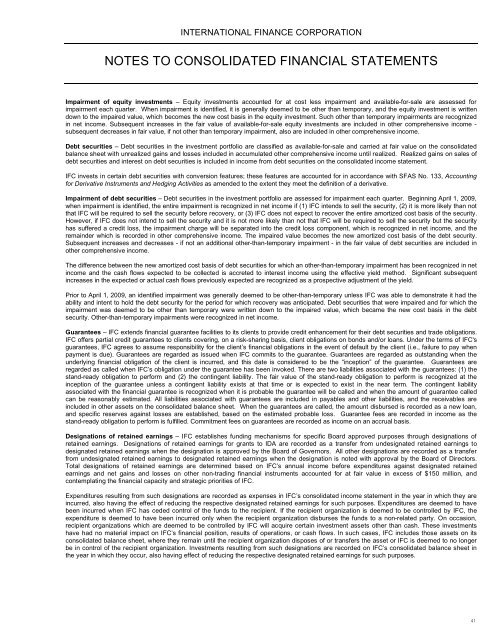Volume 2 - IFC
Volume 2 - IFC
Volume 2 - IFC
You also want an ePaper? Increase the reach of your titles
YUMPU automatically turns print PDFs into web optimized ePapers that Google loves.
INTERNATIONAL FINANCE CORPORATION<br />
NOTES TO CONSOLIDATED FINANCIAL STATEMENTS<br />
Impairment of equity investments – Equity investments accounted for at cost less impairment and available-for-sale are assessed for<br />
impairment each quarter. When impairment is identified, it is generally deemed to be other than temporary, and the equity investment is written<br />
down to the impaired value, which becomes the new cost basis in the equity investment. Such other than temporary impairments are recognized<br />
in net income. Subsequent increases in the fair value of available-for-sale equity investments are included in other comprehensive income -<br />
subsequent decreases in fair value, if not other than temporary impairment, also are included in other comprehensive income.<br />
Debt securities – Debt securities in the investment portfolio are classified as available-for-sale and carried at fair value on the consolidated<br />
balance sheet with unrealized gains and losses included in accumulated other comprehensive income until realized. Realized gains on sales of<br />
debt securities and interest on debt securities is included in income from debt securities on the consolidated income statement.<br />
<strong>IFC</strong> invests in certain debt securities with conversion features; these features are accounted for in accordance with SFAS No. 133, Accounting<br />
for Derivative Instruments and Hedging Activities as amended to the extent they meet the definition of a derivative.<br />
Impairment of debt securities – Debt securities in the investment portfolio are assessed for impairment each quarter. Beginning April 1, 2009,<br />
when impairment is identified, the entire impairment is recognized in net income if (1) <strong>IFC</strong> intends to sell the security, (2) it is more likely than not<br />
that <strong>IFC</strong> will be required to sell the security before recovery, or (3) <strong>IFC</strong> does not expect to recover the entire amortized cost basis of the security.<br />
However, if <strong>IFC</strong> does not intend to sell the security and it is not more likely than not that <strong>IFC</strong> will be required to sell the security but the security<br />
has suffered a credit loss, the impairment charge will be separated into the credit loss component, which is recognized in net income, and the<br />
remainder which is recorded in other comprehensive income. The impaired value becomes the new amortized cost basis of the debt security.<br />
Subsequent increases and decreases - if not an additional other-than-temporary impairment - in the fair value of debt securities are included in<br />
other comprehensive income.<br />
The difference between the new amortized cost basis of debt securities for which an other-than-temporary impairment has been recognized in net<br />
income and the cash flows expected to be collected is accreted to interest income using the effective yield method. Significant subsequent<br />
increases in the expected or actual cash flows previously expected are recognized as a prospective adjustment of the yield.<br />
Prior to April 1, 2009, an identified impairment was generally deemed to be other-than-temporary unless <strong>IFC</strong> was able to demonstrate it had the<br />
ability and intent to hold the debt security for the period for which recovery was anticipated. Debt securities that were impaired and for which the<br />
impairment was deemed to be other than temporary were written down to the impaired value, which became the new cost basis in the debt<br />
security. Other-than-temporary impairments were recognized in net income.<br />
Guarantees – <strong>IFC</strong> extends financial guarantee facilities to its clients to provide credit enhancement for their debt securities and trade obligations.<br />
<strong>IFC</strong> offers partial credit guarantees to clients covering, on a risk-sharing basis, client obligations on bonds and/or loans. Under the terms of <strong>IFC</strong>'s<br />
guarantees, <strong>IFC</strong> agrees to assume responsibility for the client’s financial obligations in the event of default by the client (i.e., failure to pay when<br />
payment is due). Guarantees are regarded as issued when <strong>IFC</strong> commits to the guarantee. Guarantees are regarded as outstanding when the<br />
underlying financial obligation of the client is incurred, and this date is considered to be the “inception” of the guarantee. Guarantees are<br />
regarded as called when <strong>IFC</strong>’s obligation under the guarantee has been invoked. There are two liabilities associated with the guarantees: (1) the<br />
stand-ready obligation to perform and (2) the contingent liability. The fair value of the stand-ready obligation to perform is recognized at the<br />
inception of the guarantee unless a contingent liability exists at that time or is expected to exist in the near term. The contingent liability<br />
associated with the financial guarantee is recognized when it is probable the guarantee will be called and when the amount of guarantee called<br />
can be reasonably estimated. All liabilities associated with guarantees are included in payables and other liabilities, and the receivables are<br />
included in other assets on the consolidated balance sheet. When the guarantees are called, the amount disbursed is recorded as a new loan,<br />
and specific reserves against losses are established, based on the estimated probable loss. Guarantee fees are recorded in income as the<br />
stand-ready obligation to perform is fulfilled. Commitment fees on guarantees are recorded as income on an accrual basis.<br />
Designations of retained earnings – <strong>IFC</strong> establishes funding mechanisms for specific Board approved purposes through designations of<br />
retained earnings. Designations of retained earnings for grants to IDA are recorded as a transfer from undesignated retained earnings to<br />
designated retained earnings when the designation is approved by the Board of Governors. All other designations are recorded as a transfer<br />
from undesignated retained earnings to designated retained earnings when the designation is noted with approval by the Board of Directors.<br />
Total designations of retained earnings are determined based on <strong>IFC</strong>’s annual income before expenditures against designated retained<br />
earnings and net gains and losses on other non-trading financial instruments accounted for at fair value in excess of $150 million, and<br />
contemplating the financial capacity and strategic priorities of <strong>IFC</strong>.<br />
Expenditures resulting from such designations are recorded as expenses in <strong>IFC</strong>’s consolidated income statement in the year in which they are<br />
incurred, also having the effect of reducing the respective designated retained earnings for such purposes. Expenditures are deemed to have<br />
been incurred when <strong>IFC</strong> has ceded control of the funds to the recipient. If the recipient organization is deemed to be controlled by <strong>IFC</strong>, the<br />
expenditure is deemed to have been incurred only when the recipient organization disburses the funds to a non-related party. On occasion,<br />
recipient organizations which are deemed to be controlled by <strong>IFC</strong> will acquire certain investment assets other than cash. These investments<br />
have had no material impact on <strong>IFC</strong>’s financial position, results of operations, or cash flows. In such cases, <strong>IFC</strong> includes those assets on its<br />
consolidated balance sheet, where they remain until the recipient organization disposes of or transfers the asset or <strong>IFC</strong> is deemed to no longer<br />
be in control of the recipient organization. Investments resulting from such designations are recorded on <strong>IFC</strong>’s consolidated balance sheet in<br />
the year in which they occur, also having effect of reducing the respective designated retained earnings for such purposes.<br />
41
















